Financial Accounts of the United States - Z.1
Recent Developments RSS Data Download
The recent developments discussed below refer to data through March 31, 2024.
- Household net worth increased $5.1 trillion in the first quarter, primarily driven by strong gains on corporate equity.
- Household debt increased at an annual rate of 2.9% in the first quarter amid continued moderate growth in both mortgage debt and nonmortgage consumer credit.
- Nonfinancial business debt growth picked up to a pace of 4.0% in the first quarter, buoyed by robust net issuance of debt securities.
Household Net Worth
The net worth of households and nonprofit organizations increased by $5.1 trillion to $160.8 trillion in the first quarter. The change in household net worth was primarily driven by an increase in the value of directly and indirectly held corporate equity, which rose by $3.8 trillion in the first quarter. The value of real estate on the household balance sheet rose by $0.9 trillion.
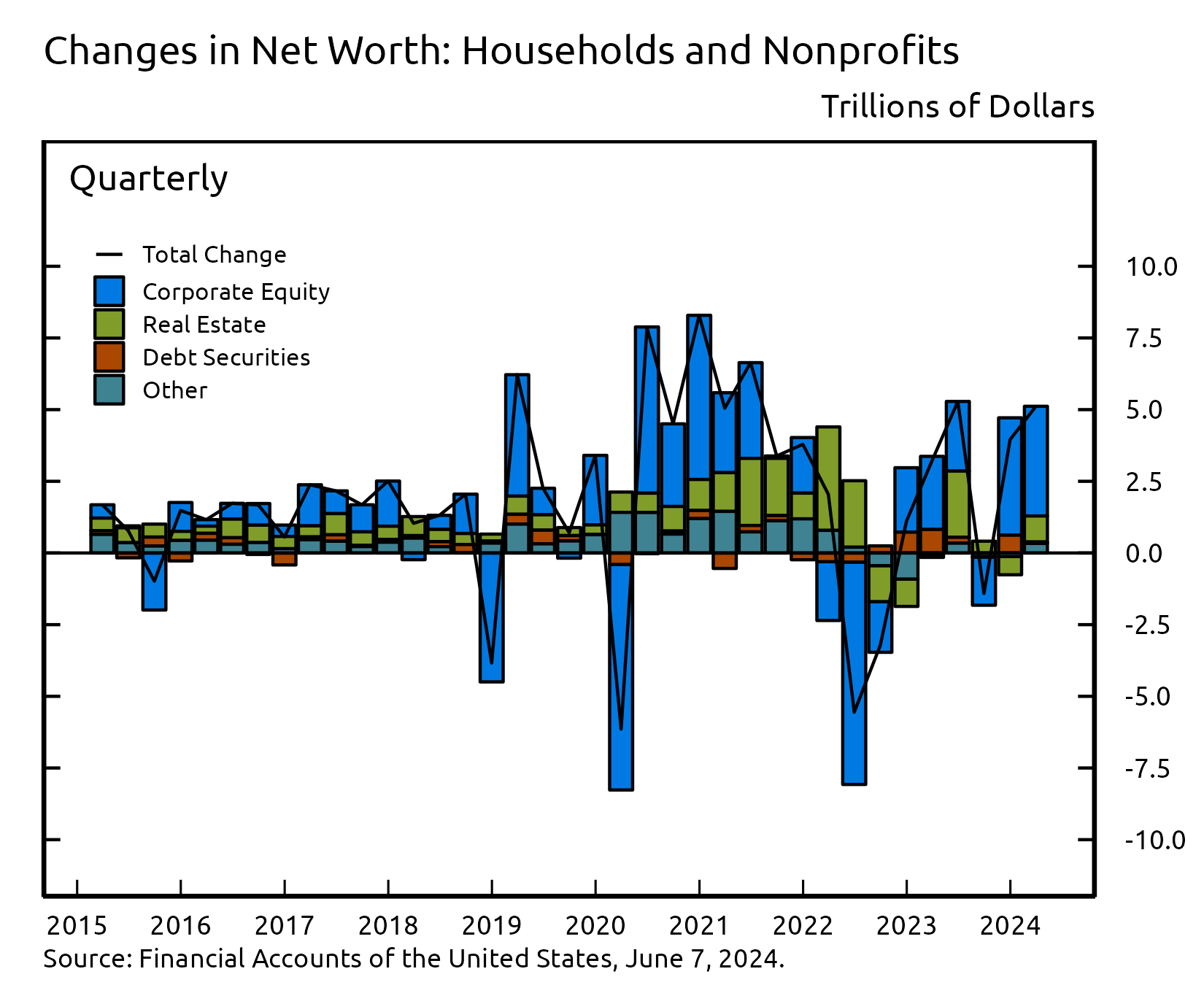
View interactive | Accessible version | CSV | Data Dictionary | Chart Note (1) |
Directly and indirectly held corporate equities ($51.0 trillion) and household real estate ($45.8 trillion) remain the largest components of household net worth. Household debt (seasonally adjusted) was $20.1 trillion.
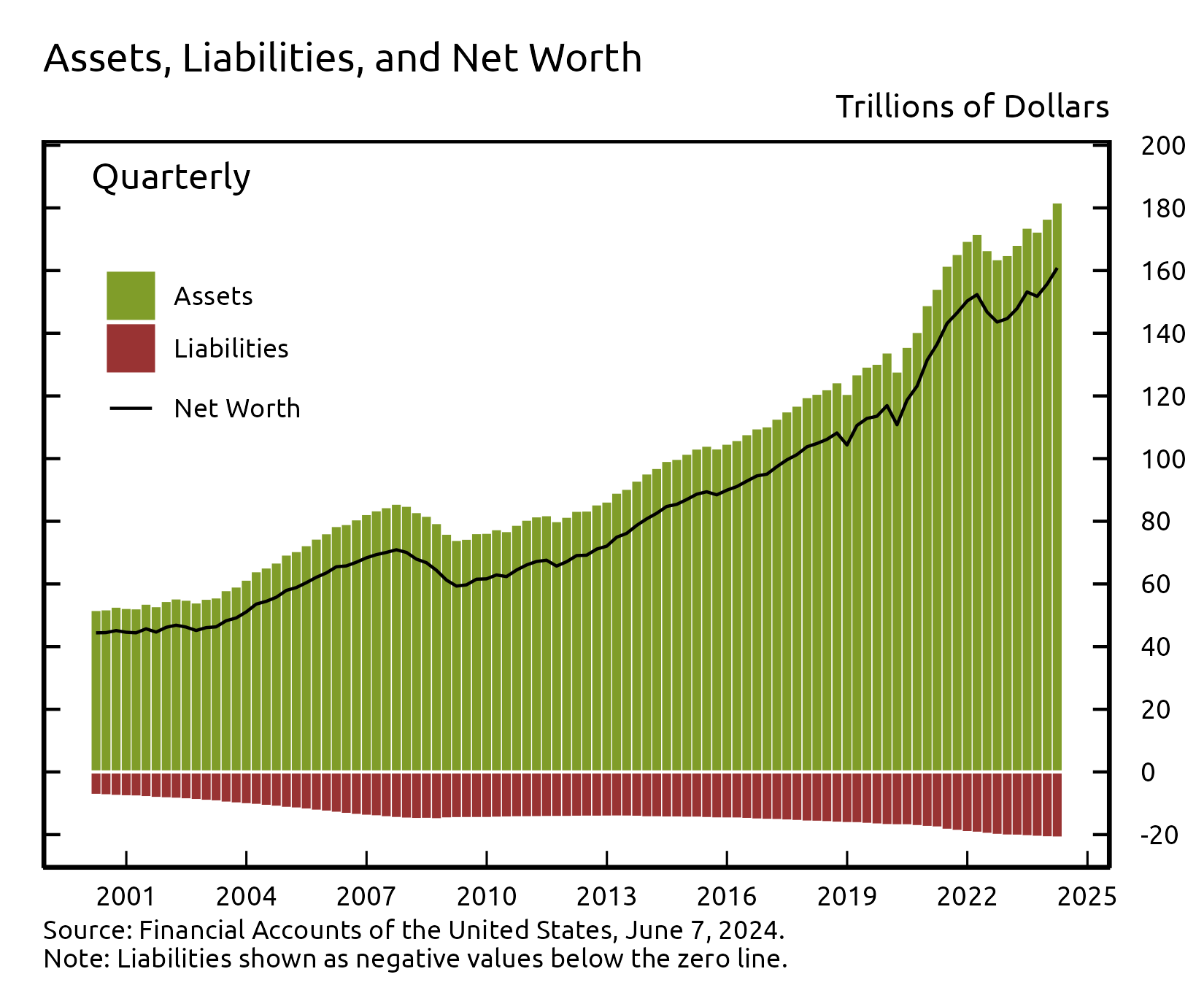
View interactive | Accessible version | CSV | Data Dictionary |
Household Balance Sheet Summary
| Description | 2022 | 2023 | 2023:Q2 | 2023:Q3 | 2023:Q4 | 2024:Q1 |
|---|---|---|---|---|---|---|
| Net Worth | 144.68 | 155.73 | 153.18 | 151.77 | 155.73 | 160.84 |
| Change in Net Worth | -5.62 | 11.05 | 5.29 | -1.41 | 3.95 | 5.12 |
| Equities | 39.74 | 47.13 | 44.72 | 43.04 | 47.13 | 50.96 |
| Change in Equities | -9.33 | 7.39 | 2.43 | -1.68 | 4.09 | 3.83 |
| Real Estate | 42.59 | 44.90 | 44.76 | 45.27 | 44.90 | 45.84 |
| Change in Real Estate | 3.69 | 2.31 | 2.22 | 0.51 | -0.36 | 0.93 |
For more data on household net worth, see table B.101
Nonfinancial debt
Household debt grew by 2.9% in the first quarter of 2024, up a bit from the previous quarter (this and subsequent rates of growth are reported at a seasonally adjusted annual rate). Home mortgage debt expanded by 2.1% and nonmortgage consumer credit grew by 1.8%.
Nonfinancial business debt grew at a 4.0% pace in the first quarter, up from a 0.6% pace in the previous quarter, reflecting robust net issuance of debt securities and moderate growth in mortgage loans.
Overall, domestic nonfinancial debt grew at an annual rate of 4.5% in the first quarter, a touch slower than in the previous quarter. Federal government debt increased at a 6.2% pace, while state and local government debt expanded by 3.0%.
The ratio of nonfinancial debt outstanding to GDP was little changed in the first quarter. For more data on nonfinancial debt, see table D.1 (rates of debt growth), table D.2 (borrowing), and table D.3 (debt outstanding).
Debt Growth by Sector
| Description | 2022 | 2023 | 2023:Q2 | 2023:Q3 | 2023:Q4 | 2024:Q1 |
|---|---|---|---|---|---|---|
| Total Nonfinancial | 5.63 | 5.13 | 6.31 | 5.36 | 4.70 | 4.53 |
| Households and Nonprofits | 6.19 | 2.78 | 3.14 | 3.17 | 2.27 | 2.90 |
| Nonfinancial Business | 5.70 | 2.02 | 1.54 | 1.31 | 0.65 | 3.96 |
| Federal Government | 6.11 | 9.76 | 12.67 | 10.60 | 10.01 | 6.20 |
| State and Local Governments | -1.54 | 0.67 | 2.82 | -0.29 | -1.08 | 3.04 |
Debt Outstanding by Sector
| Description | 2022 | 2023 | 2023:Q2 | 2023:Q3 | 2023:Q4 | 2024:Q1 |
|---|---|---|---|---|---|---|
| Total Nonfinancial | 70.16 | 73.75 | 71.94 | 72.90 | 73.75 | 74.59 |
| Households and Nonprofits | 19.41 | 19.95 | 19.68 | 19.83 | 19.95 | 20.09 |
| Nonfinancial Business | 20.66 | 21.08 | 20.98 | 21.04 | 21.08 | 21.28 |
| Federal Government | 26.85 | 29.47 | 28.01 | 28.75 | 29.47 | 29.93 |
| State and Local Governments | 3.24 | 3.26 | 3.27 | 3.27 | 3.26 | 3.28 |
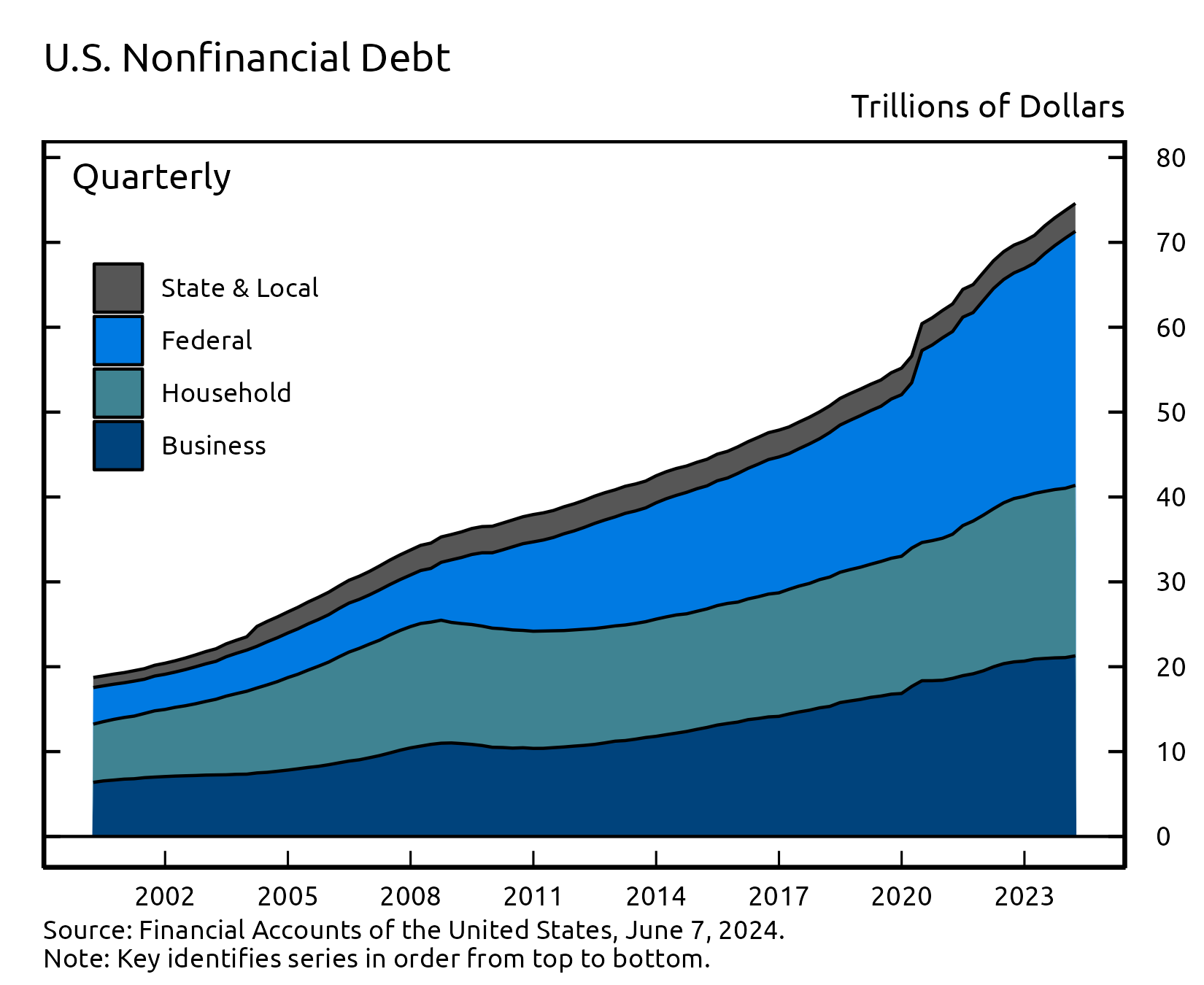
Accessible version | CSV | Data Dictionary |
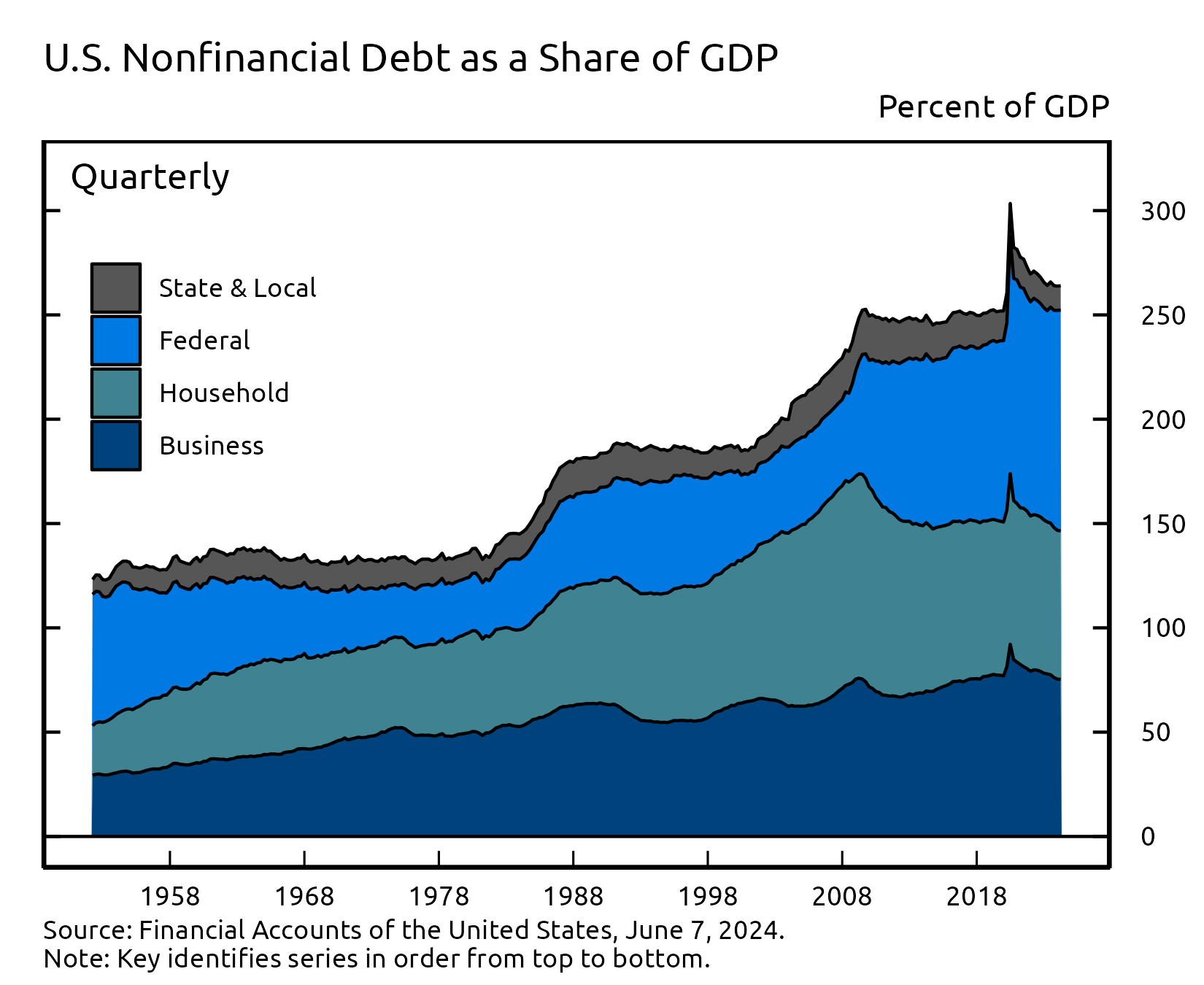
Accessible version | CSV | Data Dictionary |
Looking at the components of nonfinancial business debt, corporate bonds increased by about $112 billion in the first quarter while mortgage loans increased by $53 billion. Nonmortgage loans at depository institutions were flat, while other nonbank nonmortgage loans increased by $20 billion in the first quarter.
Overall, outstanding nonfinancial corporate debt was $13.8 trillion. Corporate bonds, at roughly $7.5 trillion, accounted for 55% of the total. Nonmortgage depository loans were about $1.5 trillion. Other types of debt include loans from nonbank financial institutions, loans from the federal government, industrial revenue bonds, and commercial paper.
The nonfinancial noncorporate business sector consists mostly of smaller businesses, which are typically not incorporated. Nonfinancial noncorporate business debt was $7.5 trillion in the first quarter. Mortgage loans, at roughly $5.4 trillion, accounted for about 72% of the total, while nonmortgage depository loans ($1.6 trillion) accounted for most of the remainder.
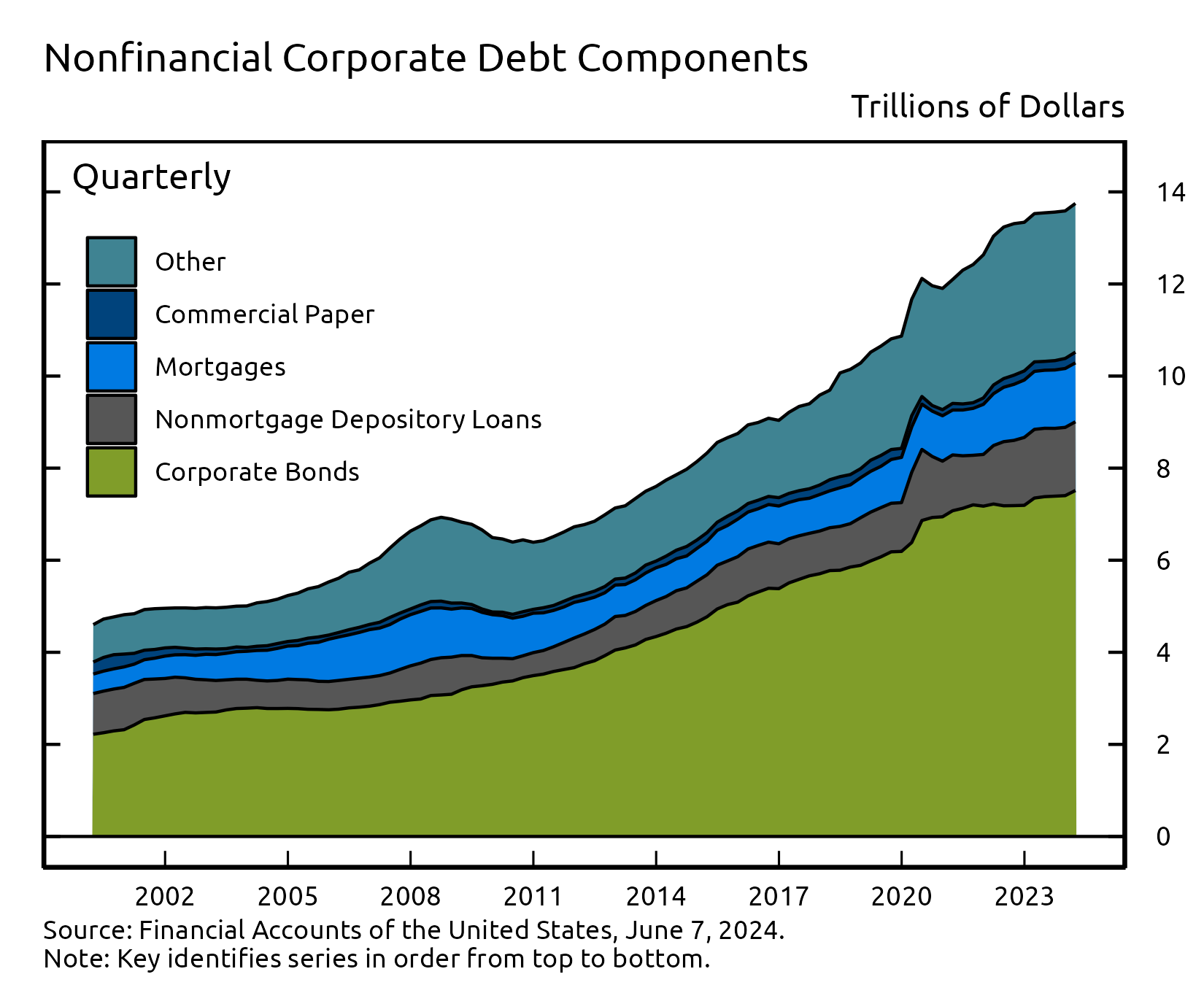
Accessible version | CSV | Data Dictionary |
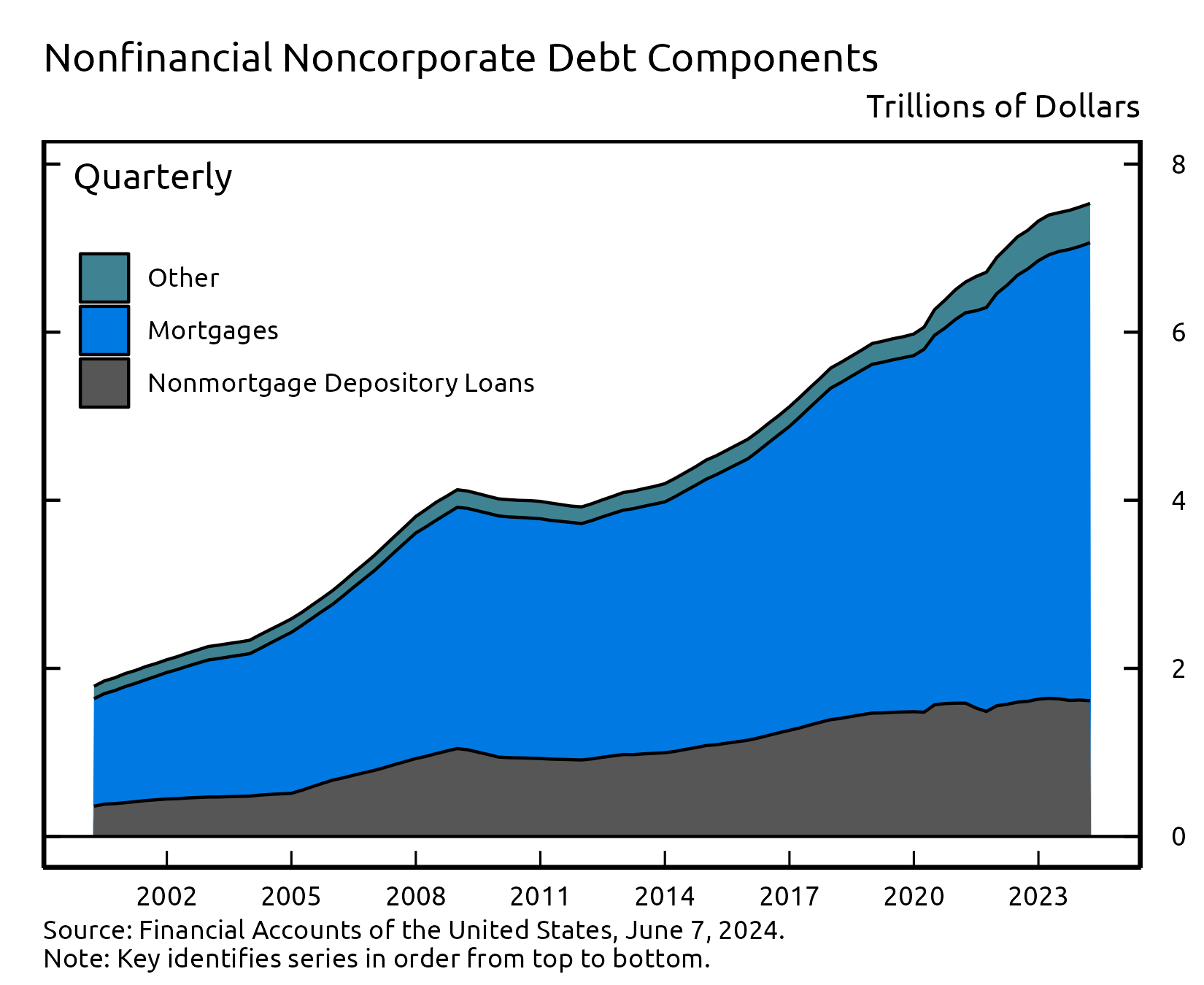
Accessible version | CSV | Data Dictionary |
For more data on nonfinancial business balance sheets, including debt, see tables B.103 and B.104.
Coming soon
- Enhanced
Financial Accounts Projects will be updated on Friday,
June 14, 2024, including the Distributional Financial
Accounts, which provide a quarterly estimate of the
distribution of U.S. household wealth.
- Financial Accounts data for the second quarter of 2024 will be published on Friday, September 12, 2024, at 12:00 noon.
Chart Notes
- Changes in net worth consist of transactions, revaluations, and other volume changes. Corporate equity and debt securities include directly and indirectly held securities. Real estate is the value of owner-occupied real estate. Other includes equity in noncorporate businesses, consumer durable goods, fixed assets of nonprofit organizations, and all other financial assets apart from corporate equities and debt securities, net of liabilities, as shown on table B.101 Balance Sheet of Households and Nonprofit Organizations.